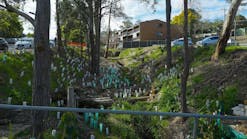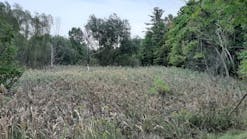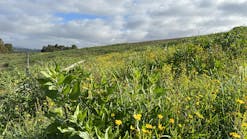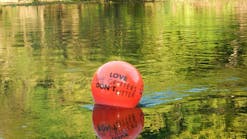Hoofbeats and Heartbeats: Wilderness Riders Tread Lightly on the Land
May 1, 2003
Spring comes slowly to the high country, and fall comes fast. For horse people, summer’s short weeks in the mountains offer a taste of heaven so sweet, it’s worth working all year to savor. And hard work it is, because for horse and rider to traverse the fragile landscapes of the high country and leave no trace of their passing requires years of training that culminate in ace judgement and skill.The hard work starts with the foal’s first day in the barn, where the wobbly newborn should be continually exposed to a variety of sights and sounds. Wilderness equestrian stewards Jack and Vicki Peasley tell me this as we’re seated around a camp table at Riley Horse Camp on the edge of the Mt. Hood Wilderness in the northern Oregon Cascades. It is an early summer weekend, and the campground is bustling with trucks, trailers, kids, and dogs. Horses of every breed stand snorting and whinnying at their crossties. People are hustling around with buckets, rakes, and ropes in anticipation of tomorrow’s rides up the mountain. Late afternoon sunlight filters through the branches of mountain hemlock and Douglas fir. We are watching a party trying to unload their horse, which is kicking up a horrible hullabaloo inside the trailer. When they finally get it down the ramp, it shies and skitters sideways at the lane striping on the campground road.Start at Home
Before horses are expected to graze in hobbles in the backcountry, they should have lots of practice at home.Jack and Vicki talk softly about how they condition their young horses to expect the unexpected. One day they’ll drape a tarp on a fence rail and set a hose on the barn floor. The next day they’ll leave a 5-gal. bucket in the barn doorway. In the woods, a horse should not get jumpy over a passing hiker’s flapping bandana or a fluttering leaf. It shouldn’t spook at a crow’s cackle or a shout in the woods. The safety of both the horse party and passersby can depend on this. And ultimately the condition of equestrians’ wilderness campsites up higher on the mountain can depend on the horses’ self-confidence.The Peasleys’ horses wait patiently at their crossties at base camp, nibbling this and that. They are alert but not bothered by the slamming of truck doors and banging of pails in the campground. Nearby, however, an anxious horse has torn up the ground all around his crosstie. He is wild-eyed and jittery. It takes practice to learn to stand tied at a rail, says Vicki, and the lessons should start at home. After the horse masters the art of being tied in the barn and pasture, horse and rider can practice on day rides so that the horse eventually learns to stand tied in many different settings. Next, the horse needs to be taught to graze on hobbles and quietly stand tied to a high line. There are many things to learn and practice before horse and rider are ready for the wilderness.Jack and Vicki get up to lend a friendly hand to the owner of the anxious horse. They chat for a while, and the owner decides he wants to set up a temporary electric fence. So Jack goes to his own trailer to look through his emergency camp equipment and comes back with a battery-operated fence charger and some electric fencing wire. They erect a makeshift pen using the crossties for two sides and fencing the other two sides with the wire. This horse already understands electric fencing, and he settles down once he has been untied. Soon he is rummaging in his feedbag.Be Seed-Free and Weed-Free
Many horsemen feed dry pellets in base camp to avoid introducing weed seed from hay to trailheads and natural areas.
The tie trees for the high line are protected from rubbing.Non-native seed in pasture hay has become an item of concern for wilderness managers. Introduced weed seeds can spread quickly in campsites, roadsides, and trails. For this reason, the Peasleys don’t feed hay at the trailhead base camp. Instead, they feed compacted pellets. Before they leave home, they brush down their animals and pick their hooves to minimize the chances that the horses will transmit exotic plant seeds to the trailhead or backcountry.Before getting their stock settled at their crossties at base camp, Jack and Vicki raked the fir needles and leaf litter out of the area where the horses would be tied. They brought the apple picker and muck bucket out of the trailer so they can clean out the stock area periodically. When they get ready to leave, they will rescatter the leaf litter in the area where the horses were tied. They’ll haul the manure home or dump it in the camp facility. When they pull out of camp, it will be hard for anyone to tell that a horse party had camped there at all.The Spanish brought horses to Mexico under the conqueror Hernando Cortés in 1519. By 1600 the western Plains Indians had incorporated horses into their culture for buffalo hunting, battling other tribes, and resisting the waves of westward-moving settlers. Horses enabled the exploration and settlement of the Louisiana Purchase lands and the Oregon Territory. They facilitated vast Spanish cattle operations in the Mexican territory of California. After mountain man Joseph Walker rode over the Sierra Nevada range and discovered the awesome Yosemite Valley around the fall of 1833, he and his ragged party of 60 men met Indians who traded them fresh horses. Horses powered agriculture, hauled in nets of salmon, helped build the railroads, and skidded timber out of the woods. They rushed the mail cross-country. They pulled streetcars, carried raw materials to factories, and then hauled the manufactured goods to market. Horses enabled the construction and operation of mines in rugged country and facilitated nearly a century of sheep grazing in the alpine meadows of the Intermountain West. In short, for 400 years horses were an integral part of the exploration, settlement, and development of North America and have always been a presence in the wilderness.Protect Wilderness by Teaching OthersToday’s backcountry equestrians are passionate about preserving the traditions and skills of wilderness horsemanship. But many are pursuing this with a new twist: a Leave No Trace ethic focused on visiting the wilderness with the lightest possible touch (see www.LNT.org). They realize that more people are flocking to the wilderness than ever before and that wilderness preservation relies on the cooperative efforts of all trail users. This, says Karen Bragg of Oregon Equestrian Trails, is because one thing is certain: “There will never be any more wilderness than there is today. We have to take care of what we have.”Practice Makes Perfect
Most horses learn to cross wild water little by little. Just as training begins with the new foal in the barn, wilderness stewardship also begins at home. “Wilderness is not for beginners,” stresses Bragg. She recommends that beginners practice riding on logging roads and in state parks. Horse and rider need to rack up many, many successful problem-solving experiences before taking on the challenges of the high country. It doesn’t do to overface a horse in a demanding situation, she cautions.It is easy to imagine how effortless it must be to ride into the wilderness on the back of a horse. Most of us who trudge up to the alpine zone laden with backpacks don’t exactly think of horsepacking as work. In fact, as we labor up long pitches with the occasional horse waltzing by, horsepacking starts to look downright cushy. But in actuality, the poetry we see in a horse and rider flowing over the wilderness landscape is the end product of years of hard work and experience.For example, says Bragg, when a novice rider’s horse stumbles on a rocky, narrow trail, the rider’s instinctive upward startled reaction can get both horse and rider into trouble. Yet with practice, a rider can retrain her own instincts so that, in a situation like this, she will automatically drop her center of gravity, thus helping her horse to regain balance. Prior experience and confidence are essential before going into the wilderness, Bragg emphasizes, “because in a lot of situations you don’t have a few seconds to think about how you are going to react.”Other things can happen that require training and dexterity. Suppose horse and rider are descending a narrow trail on a steep cross-slope and encounter a downed tree across the trail. A saw is not available, and the off-trail area is not suitable for making a detour. The horse must be capable of backing up on command. The rider must be capable of directing the horse to pivot 180º on one foot, and the horse must have the confidence in itself and in the rider to do this. Similarly, horse and rider must have prior practice in crossing streams, stepping over logs, picking their way through rocky stretches, and successfully facing many other situations they will encounter in the wilderness.Equipment Is Key
Stock have room to move about on a high line, which minimizes their impact on tree branches, bark and roots.
Backcountry horse parties should be small to limit impact on delicate terrain.All of this adds up to having the skills and proper equipment to leave no trace on the fragile landscape of the wilderness. For many mountain riders these days, gone are the heavy, rough lumber pack boxes, waxed tarpaulins, cast-iron Dutch ovens, canvas-wall tents, dishpans, cots, and sheepherder stoves that used to be typical of horse-camping equipment. The well-outfitted horsepacking party these days is more likely to sport lightweight, waterproof, and rip-stop panniers; backpacker tents; and a stove so small that the camp cook can hold it in one outstretched palm. Gone are the canned goods, sides of bacon, and heavy-iron meat knives. In their place are dried foods and lightweight implements that allow pack parties to go light. “One person, one horse, two heartbeats,” says Bragg by way of explaining that she doesn’t take riderless horses into the wilderness.And she limits the size of the parties she takes to the high country. For, despite the feed pellets she packs in, the horses need to graze. This means that the party must camp at a suitable meadow. Bragg likes to take her party a mile or more off the main trail to make camp. When they are riding off-trail, Bragg asks her party to disperse so that they will not create a new trail in the untrammeled wilderness. She scouts until she finds a spot that has been used before. She looks for a meadow that is dry enough that the horses’ hooves will not cut into the damp earth. She keeps them well away from the meadow stream, and when they need to drink, she leads them to a stable watering place or hauls water in collapsible buckets. Because mosquito repellants that are toxic to aquatic life can wash off horses when they drink or cross streams, she applies them sparingly and never to the horses’ legs.Go Lightly on MeadowsThe horses will be hobbled in the meadow so they can drift a bit while they graze for a few hours. Bragg doesn’t put her horses on picket lines because she is careful not to concentrate the impact of their grazing. Sometimes she’ll assign the youngsters of the party to graze the horses on hand lines, making sure they keep the stock moving and away from wet areas.Leave No TraceAfter the horses have eaten, they will be tied in high lines, where they will spend the night. Wilderness-sensitive equestrians no longer favor tying their mounts to trees because of the cumulative damage that can be inflicted by horses to the bark, branches, and roots of trees. After the well-spaced high-line trees are chosen, the duff between them is raked aside and saved in piles. Then a length of rope is tied high between two trees. Nylon webbing or other protective padding is tied around each tree at the spot where the rope will pass around it. This keeps the rope from rubbing a raw spot on the bark due to the jostling movements of the stock and the use of the same tree by later parties. The horses are attached to the high line on lead ropes long enough that they will not tangle in them when they lie down. Some equestrians favor knot-savers: ingenious metal rings that can be quickly slipped from the line to loose a knot.
Children who have grown up with no-trace traditions will be among the wilderness stewards of the future.Each horse has its own lead and station on the high line. The horses can move around more than if they were tied to trees, and this minimizes soil compaction and damage to tree roots from their hooves. If it should rain, overhead tree canopy will intercept much of the precipitation, lessening direct raindrop impact on the ground that is disturbed.When the party pulls up tent stakes to leave, they will scatter the horse manure and respread the leaf litter. Their goal is to leave the wilderness looking exactly as they found it, not leaving as much as a match head, a flake of tinfoil, or a spot of toothpaste. Each member of the camp has taken pains to wash and bury human waste at least 200 ft. from water, and the party has burned or carried out all trash, including toilet paper.Back at base camp on Mt. Hood, Jack and Vicki talk about how they will camp for the rest of the summer at the edge of the high desert near the Sisters Wilderness in Oregon’s High Cascades. To the east, lush meadows grade into the juniper and sage of the high desert at 5,000 ft. Westward rise the timbered lower slopes of Packsaddle Mountain, dotted with trembling lakes and interfingered with hanging meadows. Their children and grandchildren will visit to ride with them on the intricate network of trails in this breathtakingly beautiful country. The adults of the family will help the youngsters practice the many arts of leaving no trace in the backcountry. Out on the trail, they will stop and enter into easy conversation with others, sharing no-trace tips and tricks in subtle outreach education. “People who ride in the wilderness need to talk to other users about the things they can do to leave no trace of their visit,” stresses Vicki. “After all, if we don’t, who will?”





